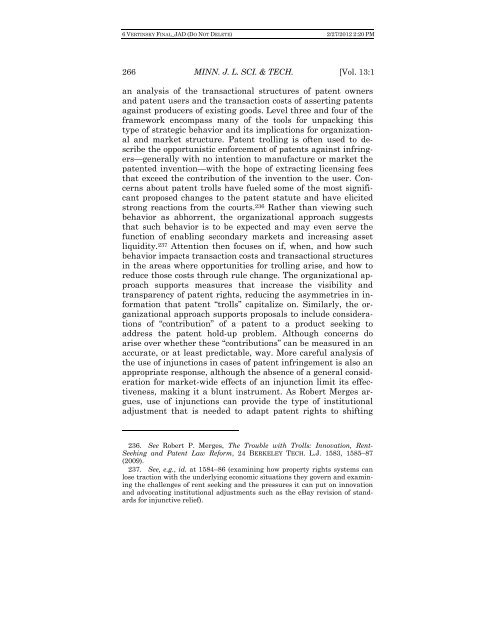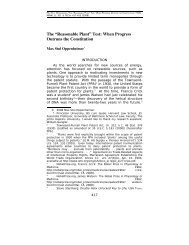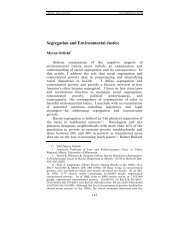An Organizational Approach to the Design of Patent Law
An Organizational Approach to the Design of Patent Law
An Organizational Approach to the Design of Patent Law
You also want an ePaper? Increase the reach of your titles
YUMPU automatically turns print PDFs into web optimized ePapers that Google loves.
6 VERTINSKY FINAL_JAD (DO NOT DELETE) 2/27/2012 2:20 PM<br />
266 MINN. J. L. SCI. & TECH. [Vol. 13:1<br />
an analysis <strong>of</strong> <strong>the</strong> transactional structures <strong>of</strong> patent owners<br />
and patent users and <strong>the</strong> transaction costs <strong>of</strong> asserting patents<br />
against producers <strong>of</strong> existing goods. Level three and four <strong>of</strong> <strong>the</strong><br />
framework encompass many <strong>of</strong> <strong>the</strong> <strong>to</strong>ols for unpacking this<br />
type <strong>of</strong> strategic behavior and its implications for organizational<br />
and market structure. <strong>Patent</strong> trolling is <strong>of</strong>ten used <strong>to</strong> describe<br />
<strong>the</strong> opportunistic enforcement <strong>of</strong> patents against infringers—generally<br />
with no intention <strong>to</strong> manufacture or market <strong>the</strong><br />
patented invention—with <strong>the</strong> hope <strong>of</strong> extracting licensing fees<br />
that exceed <strong>the</strong> contribution <strong>of</strong> <strong>the</strong> invention <strong>to</strong> <strong>the</strong> user. Concerns<br />
about patent trolls have fueled some <strong>of</strong> <strong>the</strong> most significant<br />
proposed changes <strong>to</strong> <strong>the</strong> patent statute and have elicited<br />
strong reactions from <strong>the</strong> courts. 236 Ra<strong>the</strong>r than viewing such<br />
behavior as abhorrent, <strong>the</strong> organizational approach suggests<br />
that such behavior is <strong>to</strong> be expected and may even serve <strong>the</strong><br />
function <strong>of</strong> enabling secondary markets and increasing asset<br />
liquidity. 237 Attention <strong>the</strong>n focuses on if, when, and how such<br />
behavior impacts transaction costs and transactional structures<br />
in <strong>the</strong> areas where opportunities for trolling arise, and how <strong>to</strong><br />
reduce those costs through rule change. The organizational approach<br />
supports measures that increase <strong>the</strong> visibility and<br />
transparency <strong>of</strong> patent rights, reducing <strong>the</strong> asymmetries in information<br />
that patent “trolls” capitalize on. Similarly, <strong>the</strong> organizational<br />
approach supports proposals <strong>to</strong> include considerations<br />
<strong>of</strong> “contribution” <strong>of</strong> a patent <strong>to</strong> a product seeking <strong>to</strong><br />
address <strong>the</strong> patent hold-up problem. Although concerns do<br />
arise over whe<strong>the</strong>r <strong>the</strong>se “contributions” can be measured in an<br />
accurate, or at least predictable, way. More careful analysis <strong>of</strong><br />
<strong>the</strong> use <strong>of</strong> injunctions in cases <strong>of</strong> patent infringement is also an<br />
appropriate response, although <strong>the</strong> absence <strong>of</strong> a general consideration<br />
for market-wide effects <strong>of</strong> an injunction limit its effectiveness,<br />
making it a blunt instrument. As Robert Merges argues,<br />
use <strong>of</strong> injunctions can provide <strong>the</strong> type <strong>of</strong> institutional<br />
adjustment that is needed <strong>to</strong> adapt patent rights <strong>to</strong> shifting<br />
236. See Robert P. Merges, The Trouble with Trolls: Innovation, Rent-<br />
Seeking and <strong>Patent</strong> <strong>Law</strong> Reform, 24 BERKELEY TECH. L.J. 1583, 1585–87<br />
(2009).<br />
237. See, e.g., id. at 1584–86 (examining how property rights systems can<br />
lose traction with <strong>the</strong> underlying economic situations <strong>the</strong>y govern and examining<br />
<strong>the</strong> challenges <strong>of</strong> rent seeking and <strong>the</strong> pressures it can put on innovation<br />
and advocating institutional adjustments such as <strong>the</strong> eBay revision <strong>of</strong> standards<br />
for injunctive relief).






